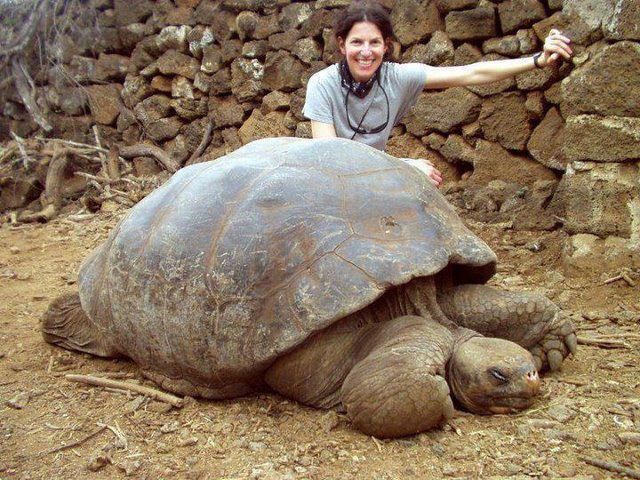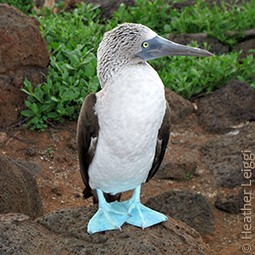The Galapagos: Where the Wild Things Are

What destinations are on your travel bucket list? The Great Pyramids of Giza? The Eiffel Tower? The Great Wall of China? Mount Kilimanjaro? Machu Pichu? We all have our list, some more grand than others. The five hundred people from all across the United States who participated in the virtual visit to the Galapagos Islands were in for a real treat. On behalf of AARP Virginia, Bonnie Becker, world traveler extraordinaire shared her expertise and travel experience to what is regarded by many as one of the most fascinating destinations in the world.
The Galapagos, an archipelago of thirteen islands ranging in size from 5 ½ square miles to 1,771 square miles, six smaller islands and scores of islets were all formed from volcanic activity. Their origin began to surface between three and five million years ago. Located along the equator about 600 miles off the coast of Ecuador, the islands are situated at the convergence of the Humboldt and Panama currents and rests on the Nazca Plate which is in a constant state of movement eastward toward South America.
The unique flora and fauna of the islands draw the curious to want to visit. Because of the isolation the endemic species found there have evolved within the ecosystem of the area resulting in particularly remarkable, special, and unusual animals and plants that have confounded and awed observers, the likes of which include serious scientists like Charles Darwin as well as the current day casual tourist. The Galapagos Islands are the only place in the world you will find the giant tortoise that can weigh in up to a quarter ton and are five feet in length. The most famous was Lonesome George, aka Solitario Jorge. George is believed to have hatched circa 1910 and before his death in 2012 was said to be the “rarest creature in the world” and the last of his species. Efforts to mate George with a species near to his failed and he died without heirs to his kind. His taxidermied remains are on display at Galapagos National Park. George has become a symbol of the need for conservation efforts in the Galapagos and throughout the world.

The blue footed booby is another endemic species, a sea bird whose mating habits are a stunning dance of courtship (https://www.pbs.org/video/nature-dance-blue-footed-booby/) but we learned that mating for life is not among their values. Sea birds migrated to the islands from other areas millions of years ago often riding the winds and evolved in the very harsh conditions to survive in the developing ecosystem there. Land birds in the islands are more rare because of the arduous trip necessary to get there.

There are 57 species of animals on the Galapagos Islands, twenty-seven of which are found only there, and some are found only on a single island there. Reptiles other than the giant tortoise abound. The land iguana with is golden hue of color is one of the showiest found in the world today and the marine iguana found there is the only of its kind anywhere in the world. The marine iguana can forage for its food source underwater, mostly algae, and very large males have the ability to reportedly dive up to thirty feet and have been timed at remaining submerged for more than a quarter to half an hour.
For species like the tortoise that couldn’t swim or have enough endurance to fly on the air currents to reach Galapagos shores, experts believe they may have arrived on a raft of vegetation because they were able to survive the salt and the sun of weeks at sea.
All plants on the islands came from other places. Plants that needed to be pollinated to propagate did not survive because the required insect or bird needed to pollinate did not arrive at the same time. Consequently, there are few big showy flowering plants because of that poor timing. The plants that did make it to the islands are thought to have come as seeds or spores likely on the feet or feathers of sea birds or perhaps though their gut or like the seeds of the dandelion, came in on the wind carried hundreds of miles to evolve into a plant call Scalesia trees. Though not strictly trees they grow as large as trees, collecting moisture from the clouds in the air that helps to provide moisture for other plants in their ecosystem.
While seamen were harvesting the giant tortoises to take with them as a durable food source, they were leaving an ugly footprint behind. Because the tortoises were low maintenance eating very little and going without water for up to a year, pirate ships, merchant vessels, naval frigates and whaling ships depleted their numbers significantly in the 19th century. They left behind rats, goats that overgrazed available vegetation, dogs that became feral, and pigs that feasted on tortoise eggs and the young reptiles, further depleting their numbers.
The islands were thought to have been discovered in 1535 when a Dominican priest was blown off course while sailing down the coast of Peru. Finding no indigenous population because of the inhospitable conditions, pirates and buccaneers used the desolate islands as a hideout and though there were attempts along the way at fishing and farming, the efforts bore no fruit.
The most successful use of the islands was regrettably as a brutal prison, but they were mostly uninhabited until the early 1800s. The first wildlife sanctuaries were declared in 1934 with Galapagos National Park being declared in 1959. The Charles Darwin Research Center was opened in 1964. In 1978 UNESCO declared the Galapagos Islands a National Heritage Site for Humanity. In 1998 with an expansion from 27,000 square miles to 51,000 square miles, Galapagos Marine Reserve became the world’s largest marine reserve.
The conundrum now has become, how can the uniqueness of the islands that has put them on so many bucket lists be balanced with the conservation of what is indisputably a world treasure without the risk of further enlarging the human footprint that has been historically so very destructive?
Few could have said it better than fellow AARP Virginia volunteer, Don Harmon, of the Northern Virginia Leadership Team who observed, “One cannot look at the Galapagos Islands and fail to see the complexity of earth’s geology and how opportunistic life is.”


